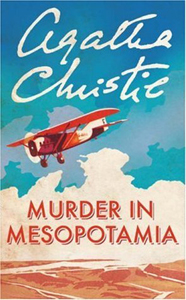“Murder in Mesopotamia” (1936) is entertaining, but it doesn’t hold up to a close analysis the way Agatha Christie’s top-shelf novels do. In a way, it’s vintage Poirot: You could hand this book to a newbie and say “This is the template for a Poirot mystery.”
The detective, who happens to be vacationing in the region, arrives at a house in Iraq where Mrs. Leidner, the wife of the archaeological dig boss, has been murdered. The single-story house is a series of rooms arranged in a square configuration around a courtyard, and the author provides a handy map.
A closed-courtyard mystery
Even more so than usual, we’re encouraged to use order and method to figure out the logistics of the crime. It seems no one could get in through the courtyard gate (the only entrance) without the servants noticing. If someone did, how? And if someone from inside the house/courtyard killed the woman, how and why?

“Murder in Mesopotamia” (1936)
Author: Agatha Christie
Genre: Mystery
Series: Hercule Poirot No. 13
Settings: Hassanieh, Iraq; Tell Yarimjah, Iraq; 1933
Noting that this is one of those “psychological” cases, Poirot interviews the dozen or so residents/suspects one by one, then later thinks about them one by one — using the narrator, Nurse Amy Leatheran, as a sounding board. Poirot is holding the reader’s hand via Amy.
But “Mesopotamia” is reasonably complex – including vast backstories about Mrs. Leidner and others – so it’s a good time to be deliberate. I admit I didn’t solve the case even with Christie nudging me to play along.
The author is successful enough by now that she’s allowed to break writing rules, but “Mesopotamia” could’ve used more “show” and less “tell.” Mrs. Leidner is a study in contradictions, sure, but it should’ve been possible to show the reader more of her behavior in the early chapters. Instead, we get the nurse and others telling Poirot how Mrs. Leidner could be nice to some people and mean to others.
A professional Poirot
Poirot is all business on this case. (Maybe he has a premonition that he’ll be needed to solve a murder on a certain train soon after.) I’m shocked that 200-plus pages go by without the persnickety sleuth complaining about the sand in Iraq, like he does in the Egypt-set short story in “Poirot Investigates.” Is it possible he only complains if Hastings is on hand to hear it?
With a dig site nearby and lots of locals employed, it’s too bad that this story could’ve been set in any location (provided there would be an explanation for the unusually designed house).
Although there are some nice details about archaeological work, including the use of hydrochloric acid to clean artifacts, we don’t get enough of a sense of place about Iraq in terms of culture, geography or weather. The author, like Mrs. Leidner, mostly prefers to stick to the house and courtyard.

Amy is no Anne
“Mesopotamia” is narrated by Amy, so it has first-person immediacy, but the nurse is rather bland in personality and action when we compare her to more adventurous narrators such as Anne from “The Man in the Brown Suit.”
Still, with nudging from Poirot, Amy is a decent observer of the behavior of the dozen or so characters/suspects. Covering a wide range of nationalities (although none are Iraqis, oddly) and job titles, some of these people pop off the page, but others remain blanks to me.
Poirot, in a rather mean moment, even lectures one of them to stop being so meek and develop an attitude; it’s almost like Christie is frustrated that this character won’t come alive.
Christie is primarily interested in odd traits found in relationships, including the thin line between love and hate. Through Mrs. Leidner, the author explores the type of person who uses others as her own live entertainment – giving a prod here and a nudge there so soap opera stories will play out in front of her.
A creepy vibe
Christie wills “Mesopotamia” to be as good as it is, writing about the fear felt by Mrs. Leidner and other household residents. The author flirts with a horror vibe as she peppers in anonymous letters, creepy faces in windows, strange deathbed phrases, and an inexplicable tension among the dig team.
In one of the later meals among the household, Amy says she’s sure if a utensil was dropped, someone would scream in terror.
My review sounds negative because I’m thinking about why “Murder in Mesopotamia” didn’t strike me as great after I closed it. But I can’t complain about my page-by-page experience. Even when character and relationship details don’t click, Christie can deliver the structure and connections of a mystery plot in her sleep.
Every week, Sleuthing Sunday reviews an Agatha Christie book or adaptation. Click here to visit our Agatha Christie Zone.

